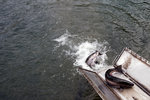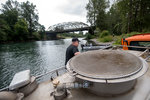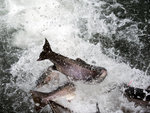


In these days of evolving enlightenment, recycling is typically not controversial but a generally accepted practice. Sure, some folks may forgo the task of sorting their refuse, but it is a rare occurrence indeed for a person to confront another over their aluminum can retirement fund.
When it comes to recycling steelhead on the Cowlitz River though, steadfast opinions range far and wide.
The annual steelhead recycling program, approved by the state Department of Fish and Wildlife and conducted by Tacoma Power, began on June 15 and is scheduled to run through Aug. 15. During the first three weeks of the program, which takes returned steelhead from the Cowlitz Salmon Hatchery separator and trucks them back downriver in order to give anglers a second chance to hook the summer-run steelies, Tacoma Power reportedly recycled some 750 fish. The steelhead deposits are made at the Cowlitz River’s I-5 boat launch, between exits 63 and 57 on Interstate 5.
The first few weeks, the power company delivered single shipments of 150 fish each week. Now, Tacoma Power has bumped up its deliveries to twice a week. The increase is a reflection of the swelling run of summer-run steelhead returning to the rank and file at the hatchery each week. By the week of July 23, Tacoma Power anticipates putting 600 steelhead back into the river.
“As the season progresses, we’re trying to get more and more out every week, as the returning numbers allow,” explained Scott Gibson, a natural resources biologist for Tacoma Power.
This week, Tacoma Power dropped off 150 or so steelhead at the boat launch on Tuesday, and they plan to bring another 150 steelies back down the river on Friday.
“It’s shaping up to be a pretty good return so far this year,” added Gibson.
All of that is good news for steelhead anglers on the Cowlitz River with a penchant for bonking and barbecuing their catch. However, there are vocal groups of river purists, opponents of dams and proponents of wild fish who object to the practice.
The whole reason that hatchery steelhead exist in the first place is to offset the impact of dams, which decimated self-sustaining wild stocks of salmon. That’s how Tacoma Power wound up in the fish-rearing business.
While hatcheries are mandated to offset the loss of wild fish, there are many critics who claim that the unintended cross-breeding of wild and hatchery stocks of salmonids are causing less viable fish to propagate. For the wild river purists, that is an unacceptable outcome. They say that the hatchery fish should not be in the river in the first place, and under no circumstances should they be trucked back downriver after making their initial return to the hatchery and recycled for the sheer titillation of sport anglers.
Jeff Simons has been driving fish trucks for Tacoma Power for about the last 10 years. Simons was the driver who made the steelhead delivery on Tuesday. He says that each delivery is at least 150 fish, although steelhead are notoriously difficult to count, and a few extra steelies sometimes wind up in the tanker truck. In general, “It really just depends on how many we get at the separator,” explained Simons.
Simons noted that from time to time he winds up taking the brunt of a tirade from a passionate passerby while he drops the fish off at their designated location. During the first few years he was doing the job, the vitriol seemed to be especially prevalent and potent. These days the waters have become slightly more tepid.
“It’s been a lot better than it used to be. I just try to be friendly and it seems like people are really getting to know me,” said Simons. “I’m just doing a job here.”
Simons, of Centralia, noted that, “Some people are just completely against the dams and they’ll read you the riot act.”
One way or the other, there’s always lots of interest in what Simons is up to and what he’s got sloshing around inside his big orange tanker truck.
“The fish have to get through a lot of barriers just to get to us,” admitted Simons.
On the other end of the spectrum are angry anglers who believe Tacoma Power is responsible for everything from declining salmon runs to a poor bite on a particular day.
“There’s different types of fishermen,” said Simons. “There’s sportsman and then there’s guys who are just out to snag as many as they can.”
Simons says he sees a fair amount of what looks to be snagging efforts while he’s on the job, although he can’t prove it and is quick to note that he is not a fish and wildlife enforcement officer in any capacity.
Whether intentional or not, the fact of the matter is that quite a few recycled and transplanted fish do wind up getting snagged by anglers. Simons noted the area surrounding Gust Backstrom Park in Morton, where the WDFW trucks fall Chinook salmon in order to get them up and around the Cowlitz River dams, as a place where snagged fish regularly wash ashore in varying states of decay. He says that the pin cushion markings all over the dead fall kings indicate that they’ve been snagged time and time again before giving up the ghost.
“There’s a lot of talk about implementing boundaries near the release sites,” said Simons, who thinks that regulation change would take some of the pressure off of the freshly recycled salmonids.
“I think for the most part most of the guys that I meet are just good guys out for a good time,” said Simons, although he noted that on numerous occasions he has had hooks go buzzing by his ear from impatient and uncouth anglers who can’t wait for him to get off the back of the truck before they start casting a line. “That does make me angry,” admitted Simons.
Chris Holter, 32, Toledo, is a regular on the Cowlitz River near the I-5 boat launch and he bumps into the Tacoma Power crew fairly regularly.
“Most of these guys are pretty nice guys. They’re a bunch of chatty Kathys,” said Holter.
Holter noted that the recycled steelhead typically take a few days to acclimate to their station on their river and start to bite again.
“We think they’re just in a state of shock,” explained Holter.
No matter their feelings on recycled steelies, Tacoma Power or the Washington Department of Fish and Wildlife, which approves the project, Holter pleaded with anglers who catch the recycled and subsequently tagged steelhead to report their catch to the WDFW so that the department knows how successful the program actually is.
“That’s what keeps the program going,” said Holter.